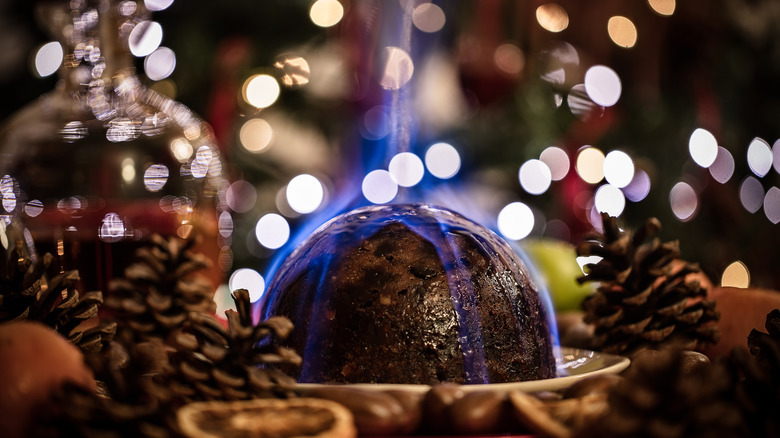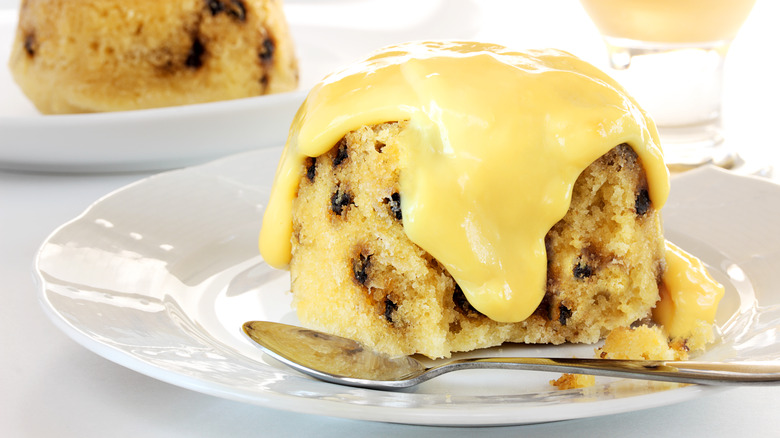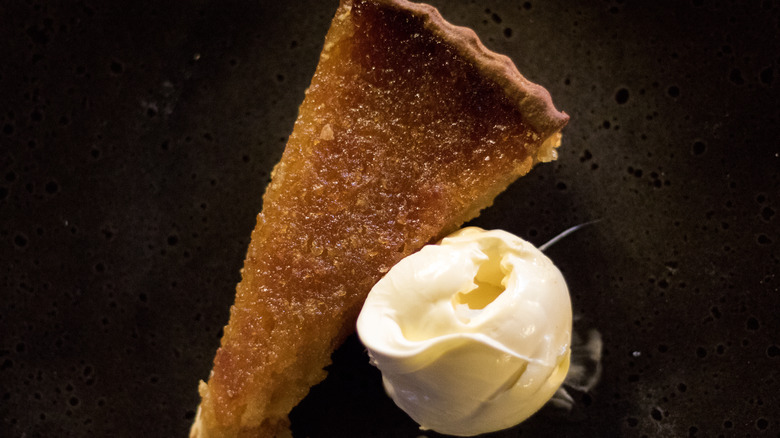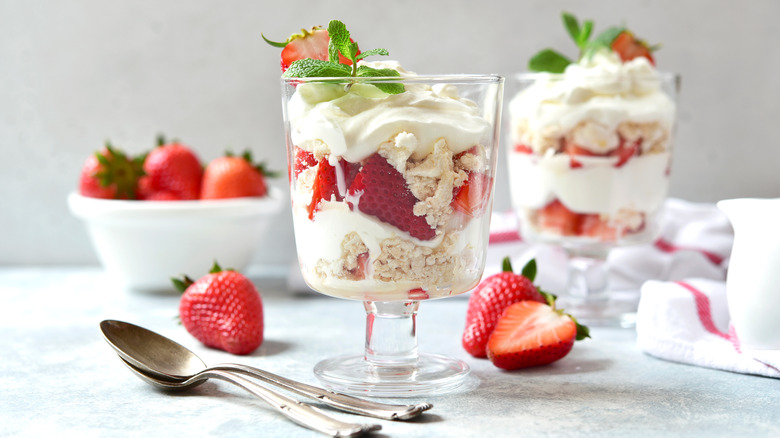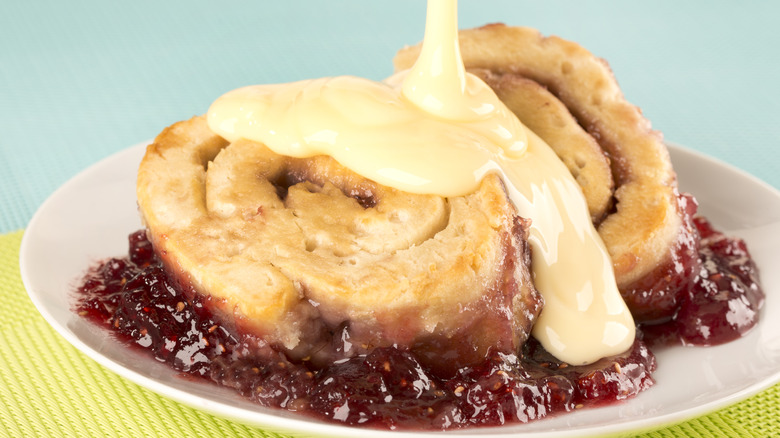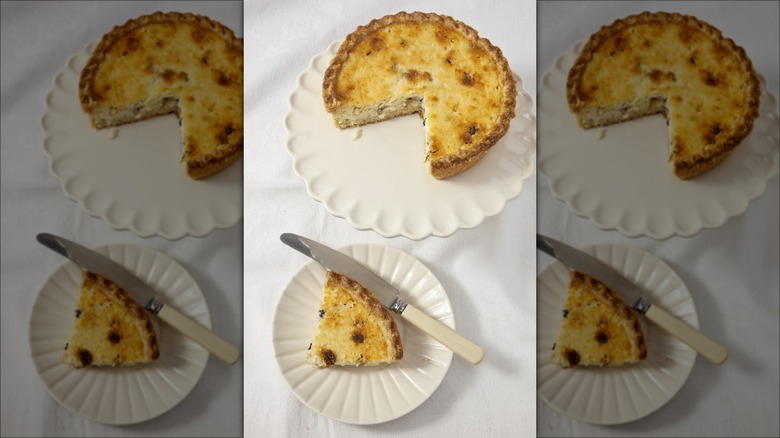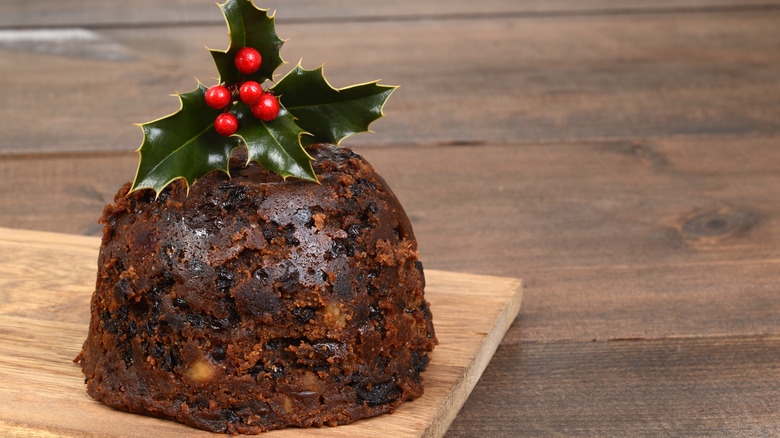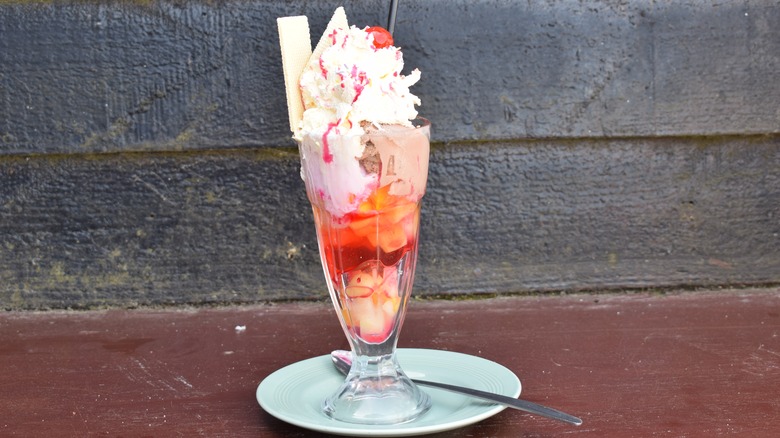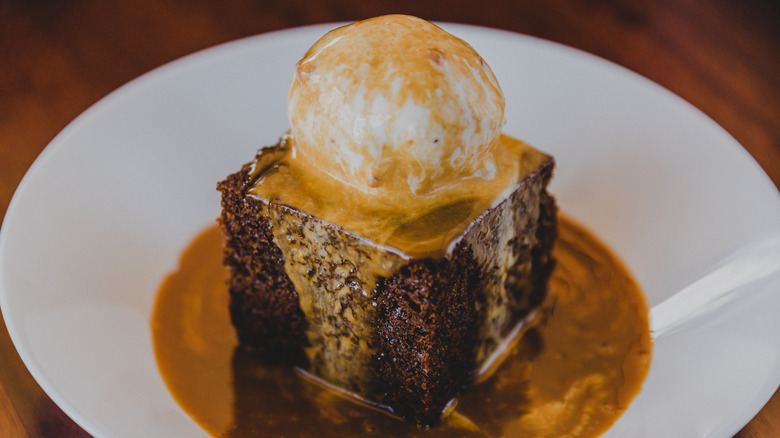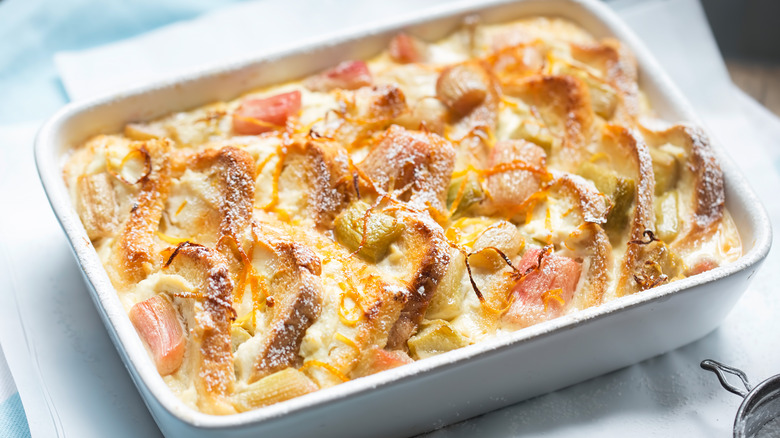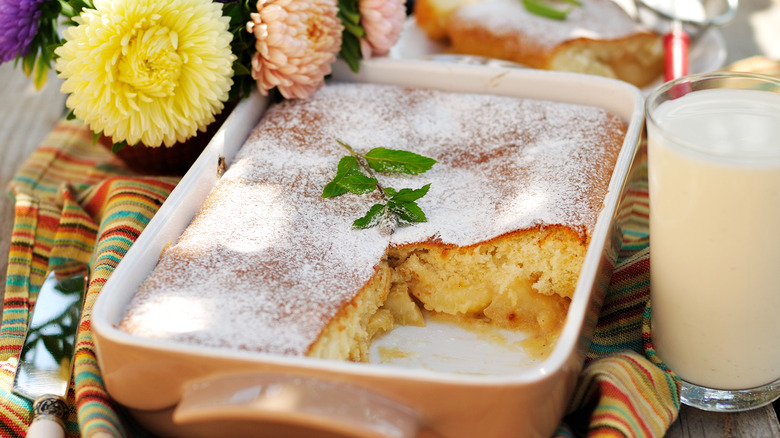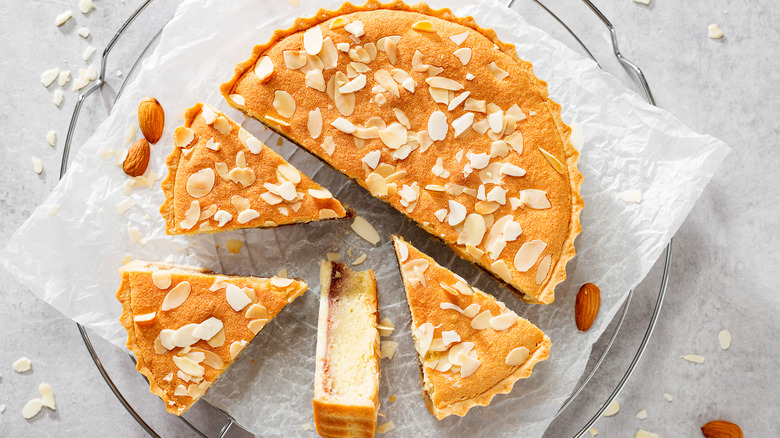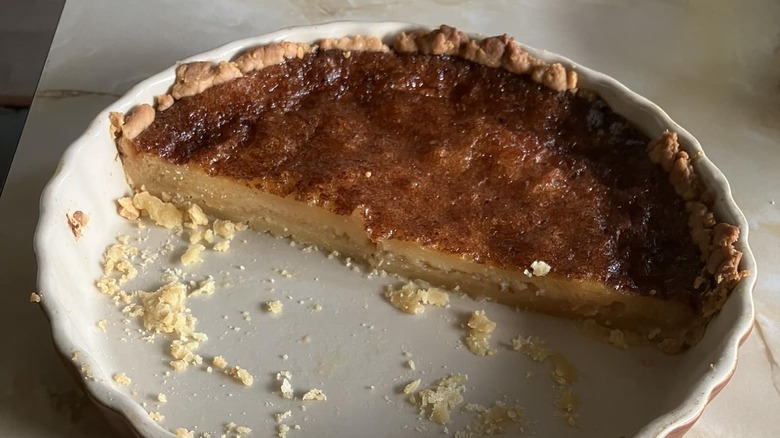Iconic British Desserts You Need To Try Before You Die
You might know about shepherd's pie and bangers and mash — but have you ever wondered what the U.K. has to offer in the dessert department? From quaint tea-time treats to hearty puddings, British confections have a unique charm that both locals and travelers appreciate.
We're digging into the iconic British desserts that are a must-try for anyone with a sweet tooth. Whether you want to taste popular classics, such as sticky toffee pudding and Bakewell tart, or you're looking to savor some of the less common regional offerings, like Yorkshire curd tart, we have a dessert trolley worth of options that will make you drool.
We've rounded up over a dozen British desserts you need to try before you die. Some are popular enough to have made it across the pond, while you aren't likely to find others outside of Britain. Next time you visit, keep this list of puddings and sweet treats to sample close at hand.
Spotted dick
Yes, we know, it's a funny name — and if you grew up in the U.K., you've definitely laughed about it. But, spotted dick is simply a steamed sponge pudding that's studded with raisins or currants. The dried fruit lends a sweet and slightly tart flavor to the dessert and stands out amidst the dense, moist, cake-like texture. It is often enjoyed with custard or a scoop of vanilla ice cream.
The origin of the name likely comes from the traditional English word "dick," which was used to describe pudding or dough. "Spotted" refers to the distinctive currants or raisins that dot the pudding, making it look spotted. The core ingredients include self-rising flour, sugar, dried fruit, and suet (a type of animal fat). However, butter can also be substituted if you want the dessert to remain vegetarian. Some recipes may also include spices like nutmeg or cinnamon for added flavor.
Spotted dick is seen as old-fashioned, so you won't find it on many menus these days. However, you may come across it at pubs or tea rooms that cater to particularly traditional tastes. It's generally fairly inexpensive, as it's a simple classic dessert that doesn't require any fancy ingredients.
Treacle tart
Treacle tart is celebrated for its rich, sweet flavor, thanks to its filling that primarily features golden syrup. This gooey syrupy interior has a distinct, buttery caramel taste that is often complemented by breadcrumbs or ground almonds, which add texture and balance to the treat. The combination contrasts the crispy pastry crust and the soft, syrupy interior, making it a beloved dessert for people with a sweet tooth.
Even though it's made using golden syrup, it's called treacle tart because "treacle" can be used to describe any viscous sugary syrup. That said, the recipe was introduced prior to the invention of golden syrup and was originally made with black treacle. You can order treacle tart for dessert in some British restaurants, especially those with traditional or British-inspired menus. You can also buy ready-made treacle tarts in British supermarkets, although it likely won't be the best example of the dessert.
Eton mess
Eton mess is a quintessentially British dessert that offers a refreshing burst of flavors and textures. It typically combines layers of crushed meringue, whipped cream, and a mixture of fresh berries or fruit compote. The meringue adds a crispy, airy sweetness balanced by the tartness of the fruit, while the whipped cream contrasts with creaminess.
The name "Eton mess" pays homage to its place of origin, Eton College, one of England's most prestigious private schools. The dessert was invented by an Eton cook in the 1930s. The "mess" refers to the haphazard assembly of the dessert, which consists of ingredients casually mixed together. However, there's a longstanding misconception that it was invented by accident when a strawberry pavlova fell apart.
Eton mess is a popular dessert in the United Kingdom and is readily available in many British restaurants. It's often featured on dessert menus, particularly during the summer when fresh berries are in season. The price can vary depending on the location, but it's generally moderate and in line with the cost of other sweet treats.
Jam roly-poly
Jam roly-poly is a comforting and hearty dessert. The pastry, made with a suet or butter-based dough, is typically dense yet tender. Meanwhile, the jam (usually raspberry or strawberry) adds a fruity sweetness that contrasts beautifully with the rich pastry. The name "jam roly-poly" is quite descriptive and refers to the jam filling and the fact that the pastry is rolled into a cylindrical shape.
When served hot it's often accompanied by custard, which adds creaminess and complements the overall flavor profile. Although it looks similar, it shouldn't be confused with a Swiss roll. Swiss rolls are made using a light Genoise sponge, while the suet pastry used in a jam roly-poly is much denser.
Like many other steamed suet puddings, jam roly-poly is seen as quite traditional and not all that trendy these days, so it's not a common addition to restaurant menus. If you do see it on the menu at a restaurant or pub, it's probably at an establishment that focuses on traditional British fare. It should be fairly inexpensive as the ingredients are basic.
Yorkshire curd tart
A Yorkshire curd tart features a flaky pastry crust filled with a mixture of curd cheese, sugar, eggs, raisins or currants, and often a hint of nutmeg or lemon zest. The result is a delightful combination of textures and flavors, with a creamy filling that contrasts the crispness of the pastry. It's somewhere between a baked cheesecake and a custard tart but made with fresh cheese curds or cottage cheese and an egg custard. It's sweet but not overly so, making it an excellent choice for anyone who appreciates a balanced dessert.
The dessert's name is fairly self-explanatory, considering its components and the fact that it hails from the county of Yorkshire in the north of England. Yorkshire curd tart is a regional specialty primarily found locally and in the surrounding areas. It isn't widely available outside of Northern England, so you'll want to be on the lookout for it in cafes and tearooms if you make it to Yorkshire.
Figgy pudding
Typically enjoyed as a festive dessert, figgy pudding is more commonly known as Christmas pudding in the U.K., and occasionally as plum pudding. It has a rich, dense, moist texture, and is bursting with a medley of flavors and sweet notes. It contains dried fruits, spices, and some form of alcohol, such as brandy or rum. While the name suggests a strong fig flavor, figs are not generally used to make it nowadays.
The pudding is steamed or boiled, which contributes to its tender consistency. As such, it's often served warm with a variety of sauces or accompaniments, such as brandy sauce or custard. if it's doused in brandy, it's commonly set alight to add an element of festivity. The flame goes out in a matter of seconds when the brandy burns off, leaving the pudding unharmed.
The dessert's name probably dates to when figs were an integral part of this dessert, whereas in pre-Victorian times, the word "plum" was used to describe any dried fruit — hence plum pudding. Christmas pudding is especially common because the dessert is almost exclusively eaten at Christmas.
If you want to try figgy pudding in the U.K., you'd better visit around the Christmas holidays, as this is the only time you'll find it in stores. It's also occasionally on restaurant menus during the festive season, but usually only as part of Christmas set menus.
Knickerbocker glory
A knickerbocker glory is a classic British ice cream sundae that's as delightful to look at as it is to eat. Served in a tall glass, it features layers of ice cream, fruit (often strawberries or mixed berries), Jell-O, crushed cookies, whipped cream, nuts, and chocolate shavings. Ingredients can vary but the dessert will contain some or all of these components. The sundae is topped with syrup or fruit sauce and often garnished with wafer cookies and a maraschino cherry on top.
Although its origins aren't entirely clear, the unusually-named dessert may have been introduced by Lyon's Bakeries in the 1920s. It's also possible that it was named after the Knickerbocker Ice Company. Before refrigeration, this company was responsible for collecting ice to be used in ice boxes, which would have been integral for storing ice cream. If you want to try a knickerbocker glory, you won't find it on your average dessert menu. Instead, seek out an ice cream parlor that specializes in traditional concoctions.
Sticky toffee pudding
Sticky toffee pudding is all about rich, sweet flavors. It consists of a dense, sticky sponge cake made with finely chopped dates, often served warm. The cake is drenched in a toffee sauce, which is buttery and caramel-like. The result is a combination of soft and slightly gooey cake with a decadent toffee coating that creates a delightful contrast in textures and a harmonious balance of sweetness. It's often served with a dollop of cream, ice cream, or custard.
When it comes to traditional British desserts, several aren't that fashionable anymore — but sticky toffee pudding is an exception. It's found on many pub and restaurant dessert menus across the pond. You can even find elevated versions of this dessert at high-end restaurants. Expect it to cost about the same as any other dessert on the menu. It's also available to buy ready-made at many supermarkets in the U.K. — just stick it in the oven or microwave to heat it up.
Bread and butter pudding
Bread and butter pudding was invented as a way to use up leftover bread. It's made by layering slices of buttered bread in a baking dish, along with raisins or currants and a rich custard mixture made with eggs, milk, and sugar. Often, vanilla and spices like cinnamon or nutmeg are added for extra flavor. As it bakes, the bread soaks up the custard, creating a tender and slightly crispy top layer, while the inside remains moist and custardy.
The buttered bread forms the layers of the pudding, while the custard mixture binds everything together and provides the dessert's signature creamy texture, punctuated by sweet bursts from the raisins or currants. This dessert is warm, slightly sweet, and wonderfully custardy, making it a beloved comfort food. Although it might not sound terribly exciting, the resulting treat is delicious.
There's still a market for traditional bread and butter pudding, and you will find it on some dessert menus at pubs and other eateries. However, it's often made with an elevated twist. For instance, instead of a plain white loaf, it might be made with croissants or brioche. You'll also find variations that use chocolate chips rather than dried fruit.
Cranachan
Over in Scotland, cranachan is a traditional dessert that combines cream, whisky, honey, and oats with fresh raspberries. The cream is light and airy, while the toasted oats add a delightful crunch. The honey adds sweetness, and the raspberries provide a tart contrast. A splash of whisky lends a subtle warmth and depth of flavor. Altogether, it makes a delicious, well-balanced dessert.
The name "cranachan" has Scottish origins, and its exact meaning or etymology is not entirely clear. Some believe it may be derived from the Gaelic word "cranach," which means "churn." Wherever the name comes from, this tasty dessert reigns supreme north of the border.
Cranachan is readily available in Scotland and can be found in many Scottish restaurants, particularly those with a focus on traditional cuisine. However, if you're looking to try it in other parts of the U.K., you are less likely to be in luck. While you might occasionally find it in restaurants outside of Scotland — especially those with a diverse dessert menu — it's uncommon in England, Wales, and Northern Ireland. When you do come across it, expect it to be moderately priced and roughly in line with other desserts wherever you're dining.
Eve's pudding
Also known as apple sponge, Eve's pudding consists of a layer of stewed apples topped with a generous layer of sponge, similar to what is used for a yellow cake. It has a comforting, homey taste that blends the sweetness of cooked apples with the soft, slightly spongy texture of the cake topping. The name "Eve's pudding" is a reference to Eve, the biblical figure from the story of Adam and Eve. The dessert uses apples as the base — the forbidden fruit that Eve was said to be tempted by Satan to eat.
The apples are lightly sweetened and may be flavored with a touch of cinnamon or nutmeg, which adds warmth and depth to the flavor. Some variations include raisins with the apples too. The cake topping, made with butter, sugar, eggs, and flour, is delicate and slightly sweet, providing a pleasing contrast to the fruity base. It may be enriched with vanilla for extra flavor. When baked, the cake forms a golden, slightly crispy top that encases the tender apples beneath.
In the U.K. it's more of a dessert you'd make at home than one you'd commonly find at restaurants. If you don't want to make it yourself, you'll need to search for an eatery that offers traditional fare and you might get lucky ... or invite yourself to a British grandma's house for dinner.
Bakewell tart
A Bakewell tart is an English dessert that features a sweet pastry crust filled with layers of jam (traditionally raspberry), frangipane (an almond sponge made with almond meal or flour), and a topping of icing or flaked almonds. The sweet pastry crust provides a crisp, buttery base, while the layer of raspberry jam adds a fruity sweetness with a slight tartness. The frangipane layer has a soft, moist texture and nutty flavor that complements the jam perfectly. The icing or flaked almonds on top add a sweet finish with a hint of crunch.
The Bakewell tart gets its name from Bakewell, a market town in Derbyshire, England. However, the Bakewell tart itself probably wasn't created in Bakewell. Rather, it's a variation on the Bakewell pudding, which was indeed invented there. The Bakewell pudding was supposedly made by mistake in the 19th century when a cook misunderstood the recipe for a jam tart.
Bakewell pudding has a puff pastry base and features a soft set custard, instead of the shortcrust base and frangipane used in the Bakewell tart. Although the tart came after the pudding, it is still popular today whereas the pudding is much less common. If you want to try a Bakewell tart, you can often find them in cafes or tearooms in the U.K. They're also widely available in supermarkets.
Amber pudding
Amber pudding is a dessert from Wales, where it's known in Welsh as Pwdin Marmeled Cymreig. If you're expecting a steamed suet pudding like a lot of traditional British puddings, you might be surprised. In fact, it's a type of tart made by filling a shortcrust pastry shell with egg custard.
The name comes from its golden hue, which is achieved by adding marmalade or candied orange peel to the custard. Not only does this give the dessert its gorgeous color, but it also infuses it with a bright, citrussy zing. While custard tarts can occasionally be cloying or one-note, this pudding has a delicious freshness that makes it stand out.
Amber pudding isn't a particularly common dessert across the U.K. You're much more likely to find it in cafes and tearooms in Wales than in England, Scotland, or Northern Ireland. So, if you want to give this delicacy a try, you'll need to hit up a traditional spot in Wales.
